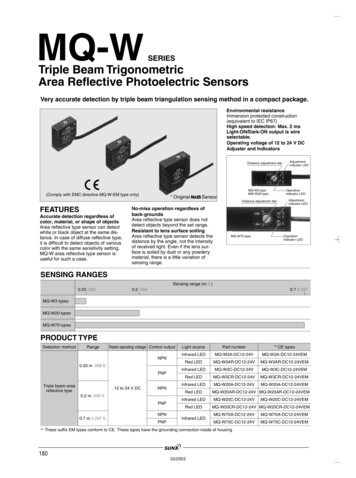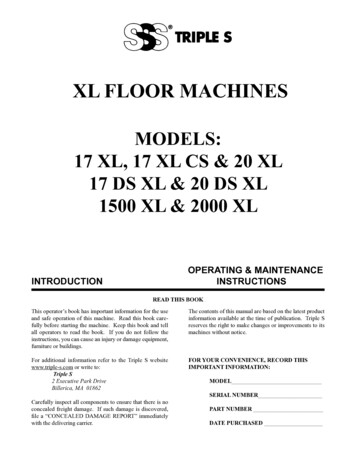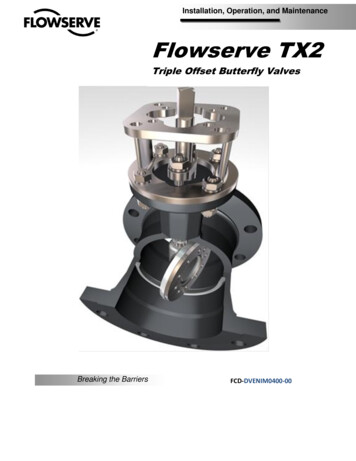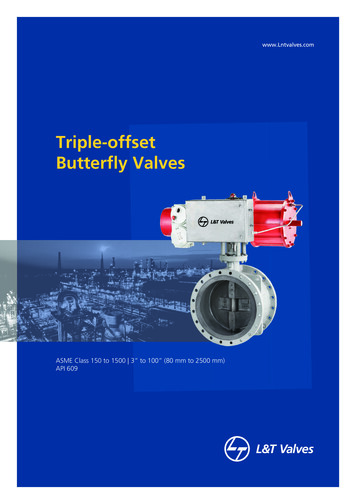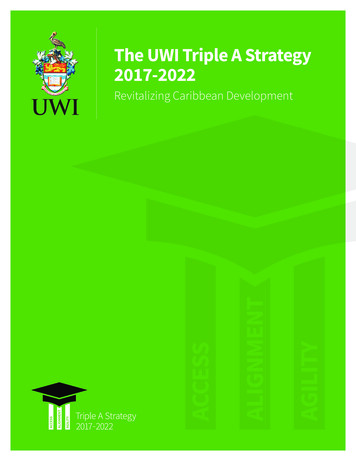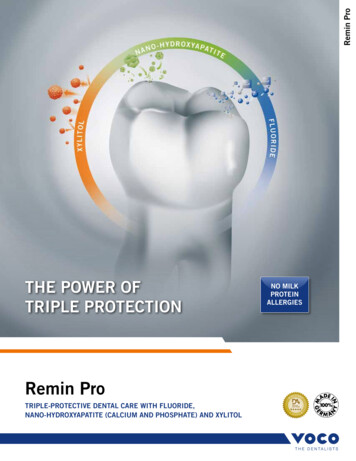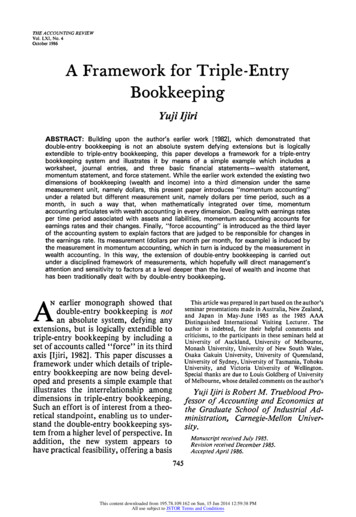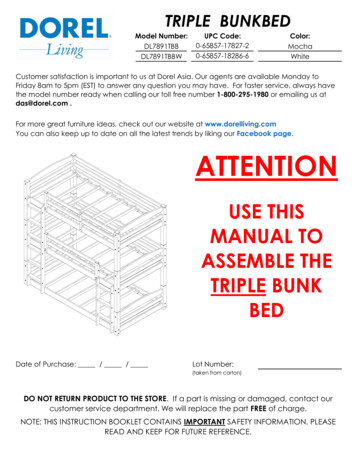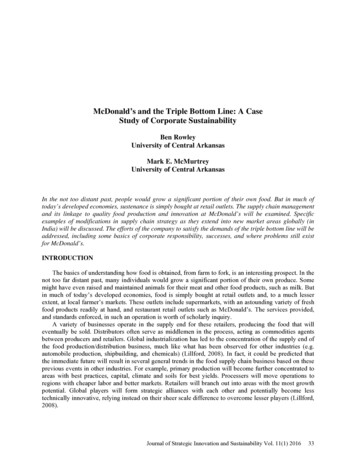
Transcription
McDonald’s and the Triple Bottom Line: A CaseStudy of Corporate SustainabilityBen RowleyUniversity of Central ArkansasMark E. McMurtreyUniversity of Central ArkansasIn the not too distant past, people would grow a significant portion of their own food. But in much oftoday’s developed economies, sustenance is simply bought at retail outlets. The supply chain managementand its linkage to quality food production and innovation at McDonald’s will be examined. Specificexamples of modifications in supply chain strategy as they extend into new market areas globally (inIndia) will be discussed. The efforts of the company to satisfy the demands of the triple bottom line will beaddressed, including some basics of corporate responsibility, successes, and where problems still existfor McDonald’s.INTRODUCTIONThe basics of understanding how food is obtained, from farm to fork, is an interesting prospect. In thenot too far distant past, many individuals would grow a significant portion of their own produce. Somemight have even raised and maintained animals for their meat and other food products, such as milk. Butin much of today’s developed economies, food is simply bought at retail outlets and, to a much lesserextent, at local farmer’s markets. These outlets include supermarkets, with an astounding variety of freshfood products readily at hand, and restaurant retail outlets such as McDonald’s. The services provided,and standards enforced, in such an operation is worth of scholarly inquiry.A variety of businesses operate in the supply end for these retailers, producing the food that willeventually be sold. Distributors often serve as middlemen in the process, acting as commodities agentsbetween producers and retailers. Global industrialization has led to the concentration of the supply end ofthe food production/distribution business, much like what has been observed for other industries (e.g.automobile production, shipbuilding, and chemicals) (Lillford, 2008). In fact, it could be predicted thatthe immediate future will result in several general trends in the food supply chain business based on theseprevious events in other industries. For example, primary production will become further concentrated toareas with best practices, capital, climate and soils for best yields. Processers will move operations toregions with cheaper labor and better markets. Retailers will branch out into areas with the most growthpotential. Global players will form strategic alliances with each other and potentially become lesstechnically innovative, relying instead on their sheer scale difference to overcome lesser players (Lillford,2008).Journal of Strategic Innovation and Sustainability Vol. 11(1) 201633
While these predictions are important to understanding the possible future of food supply chains, it’salso important to consider the logistics side of supplying food. As food is a perishable commodity, properhandling and long-distance cold chains are important to avoid waste and product loss (Taylor and Fearne,2006). Understanding and assessing variability in consumer demand is also critically important to avoidspoiled unsold product. Proper alignment of activity along the production chain with consumer demand,including timeliness of order placement, order delivery, stocking, and real-time assessment of stockpresent and demand for new stock, are all critical to maximizing profit and minimizing waste in the foodretail business (Taylor and Fearne, 2006).This topic is clearly very large and very diverse, and most likely beyond the scope of a small researchpaper such as this. As such, this paper will focus on the global retail fast-food corporation McDonald’s.The supply chain management and its linkage to quality food production and innovation in thiscorporation will be examined. Specific examples of modifications in supply chain strategy as McDonald’sextends into new market areas globally (in India) will be discussed. The efforts of the company to satisfythe demands of the triple bottom line will be addressed, including some basics of corporate responsibility,successes, and where problems still exist for McDonald’s. While this paper will not be exhaustivelycomprehensive on the topic, it should still provide an overview of the good and the bad of McDonald’ssupply chain management and overall corporate responsibility measures.MCDONALD’S AS A TOP GLOBAL FOOD SUPPLY CHAINMcDonald’s ranked #3 on the 2012 Gartner’s Supply Chain Top 25 list. This list has been publishedsince 2004, and is ranked based on the idea of demand-driven leadership. The model used, as describedby Gartner’s revolves around three basic areas: Supply management, Demand management, and Productmanagement. McDonald’s first earned its spot on the list in 2010, and has moved up the list in eachsubsequent year. The overall composite score for this listing involves opinion voting, three-year weightedROA, inventory turns, and three-year weighted revenue growth (Hofman and Aronow, 2012).While each company on this ranked list deals with its logistics and demands differently, the authorscite several commonalities among the top 25. These key characteristics include four basic characteristics:1.) an outside-in focus, 2.) embedded innovation in supply chain, 3.) extended supply chains as networks,and 4.) being excellence addicts (Hofman and Aronow, 2012).Examining McDonald’s specifically for each of these four characteristics is telling. An outside-infocus means designing a supply chain with the end product or consumer in mind. To this end,McDonald’s routinely involves its testing kitchens and marketing staff at its corporate headquarters withits suppliers and its customers. This is termed the company’s “three-legged stool” approach (Petrak,2005). Products are regularly and randomly pulled from restaurants into McDonald’s laboratories fortesting. This method is also employed at suppliers for the company. Quality and consistency are toppriorities, and adjustments will be made if either of these factors begins to falter.Embedded innovation in supply chain methods is also a high priority at McDonald’s. In 2000, thecompany formed a partnership with Sysco Corp., Cargill Inc., and Tyson Foods Inc. in a first of its kindonline supplier unification effort. This would produce a web-based marketplace to foster connections andease communications barriers between suppliers, distributors, and operators (Waters, 2000). Innovationsaren’t strictly limited to communications methods, however. The ground hamburger suppliers forMcDonald’s are continually working with the company to improve the quality and consistency of theirmutual product. In one example at the Otto & Sons facility, a new method of grinding the meat increasedboth traits in the product and provided a benefit to the entire meat industry. Representatives from thecompanies discussed how there had been no real innovation in the process in over 50 years, so the timewas right for moving into the 21st century (Young, 2005). This is just one example of the specific foodhandling innovations that McDonald’s has asked for and received from its supply chain constituents.Moving to make supply chains into extended networks is another common characteristic of successfulcompanies’ supply chains. McDonald’s has sought to do this in a number of ways, helping its suppliers toform product category councils for beef, poultry, pork, produce, and potatoes (among others) (Petrak,34Journal of Strategic Innovation and Sustainability Vol. 11(1) 2016
2005). These councils help the company to form these extended networks, facilitating communication andinnovation among chains of suppliers and ultimately helping the company deliver a more consistent,quality product. In just one example of their benefit, the original technology and methods for successfullyfreezing beef patties came out of the McDonald’s beef council. This method is now used across theindustry today (Petrak, 2005; Young, 2005).The term “excellence addicts” is an interesting one. The term “addict” implies someone who can’thelp themselves from engaging in an activity repeatedly. This term, coupled with “excellence,” implies acompany trend towards striving for excellence in a repeated and deliberate fashion. McDonald’s hasexhibited this addiction in its repeated and dogmatic drive for quality and consistency. This is illustratedin its relationships with its suppliers, bringing them to corporate headquarters and visiting their sitesrepeatedly throughout the year to foster closer contacts (Young, 2005; Petrak, 2005). It’s illustrated in thee-commerce mechanisms they have initiated to promote stronger ties and easier communication (Waters,2000). And it is illustrated in their long-term and repeated efforts to obtain feedback from customersAND suppliers in relation to their final products through quarterly/yearly food quality symposia (Giblinand Redman-Steen, 2007).The authors reporting on the Gartner ranking of McDonald’s also cite three observed trends in thesupply chains of each company on their list. These include: 1.) supply chain risk management andresilience, 2.) simplification, and 3.) a shift toward multi-local operations (Hofman and Aronow, 2012).McDonald’s facilitates supply chain risk management and resilience by using multiple suppliers, butworking closely with them to achieve close consistency (Young, 2005).While simplification isn’t necessarily the case with McDonald’s efforts, its drives towardsconsistency help make production at individual restaurants more simplified. When an individualrestaurant doesn’t have to worry that its supplies will be different from another restaurant, theirmanagement and owners have one less worry on their minds (Petrak, 2005). Last but not least, the featureof using multi-local operations is clearly evident in McDonald’s processes. In its ground beef suppliers,McDonald’s uses companies in Illinois, Oklahoma City, Nebraska, Pennsylvania, and California. Due toits concerted efforts to work with these suppliers for uniformity, the system has the benefit of being localto individual restaurants, yet with enough flexibility to shift production around the country (andpotentially the world) depending on needs of the chain as a whole (Young, 2005). Clearly, McDonald’sexemplifies the three observed trends cited by the Gartner list authors in its supply chain managementpractices and principles, helping its overall success.EXAMPLE OF MCDONALD’S GLOBAL REACH - INDIAMcDonald’s has a modest presence in India today, with approximately 30 restaurants in 5 differentcities. 95% of the ingredients served in the restaurants are sourced locally (Behera, 2009). The chainopened its first restaurant in India in 1996. However, this was no small undertaking. Due to culturaldietary differences between India and the US, the entire menu had to be reworked from the ground up.Vegetarian items had to remain completely separated from meat items. Beef and pork were excluded dueto Hindu and Muslim religious beliefs. Even sauces had to remain completely vegetarian (egg free)(Dutta, 2005). The company spent approximately 6 years prior to opening its first Indian store developingthe resources, connections, government approvals, and capacities it would need to adequately conduct itsbusiness in the new market (Dutta, 2005).Supply chain issues also existed. As the country was so far geographically from McDonald’straditional US distribution centers, food items needed to be supplied locally for freshness and quality.This presented two major problems as the company began the process of preparing for stores to open inthe new market: 1.) at that point in time, many local Indian suppliers had no real business procedures orreplicable policies, and 2.) a proper cold chain was essentially nonexistent at the time. In point of fact,when McDonald’s first began investigating opening restaurants in India, it is estimated there were only200 refrigerated trucks total in the country (Behera, 2009).Journal of Strategic Innovation and Sustainability Vol. 11(1) 201635
To alleviate the first problem, McDonald’s spent several years helping local Indian supply companiesto bring their business procedures into the latter half of the 20th century. This was a two-way process;McDonald’s needed the local suppliers to be highly effective and consistent in order to run their businesseffectively. The local suppliers needed McDonald’s (at first) to help them become better businesses.Because of this two-way process, a number of suppliers have now developed their businesses well beyondsimply supplying McDonalds’ needs. Examples include Dynamix Dairy (which supplies cheese toMcDonald’s, but also now supplies casein, skim milk powder, and other dairy products to Nestle,Britannia, and Tropicana) and Cremica (which developed its own lines of sauces, biscuits, and breads inaddition to those supplied to McDonald’s Indian operations. (Dutta, 2005). These are prime examples ofthe ways in which McDonald’s helps push other companies to develop further and become leaders in theirown fields while increasing its own business potential.As to the second problem, McDonald’s quickly realized that it wouldn’t be efficient to bring innumerous refrigerated trucks early in their development of the Indian market. As the new restaurants gotoff the ground, need for cold transport wasn’t as crucial. However, it would eventually become moreimportant to have a greater volume capacity for cold transport. To temporarily and efficiently solve theproblem, the company pioneered the use of mixed-temperature shipping trucks. Part of the truck would berefrigerated, while part of it could store frozen goods. This allowed for far more effective and affordableshipping of smaller amounts of materials to restaurants early in the burgeoning market (Behera, 2009).The development of McDonald’s restaurants in India, along with the required supply chains forlocally-sourced and culturally-approved food, p
McDonald’s facilitates supply chain risk management and resilience by using multiple suppliers, but working closely with them to achieve close consistency (Young, 2005). While simplification isn’t necessarily the case with McDonald’s efforts, its drives towards consistency help make production at individual restaurants more simplified. When an individual restaurant doesn’t have to .

